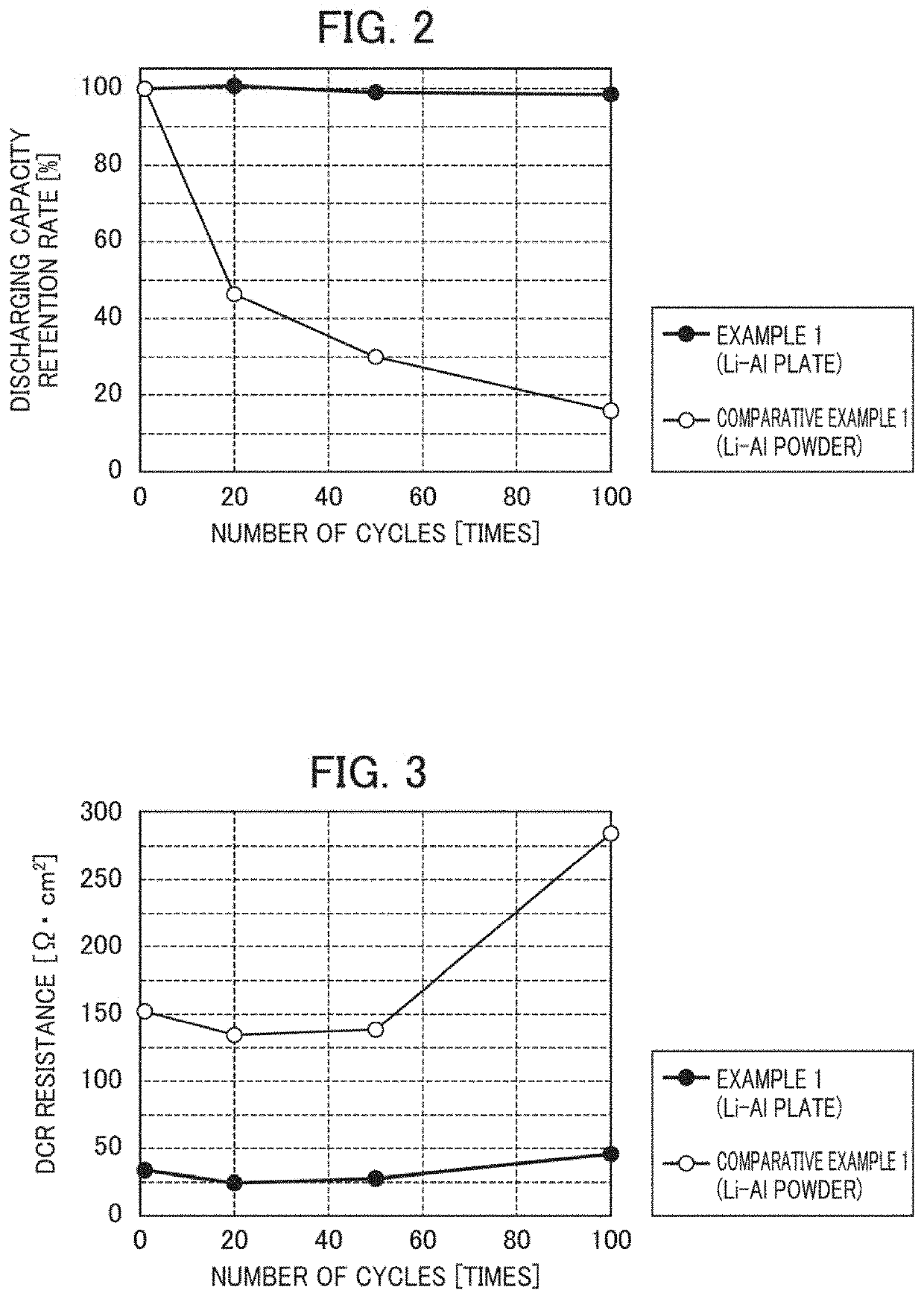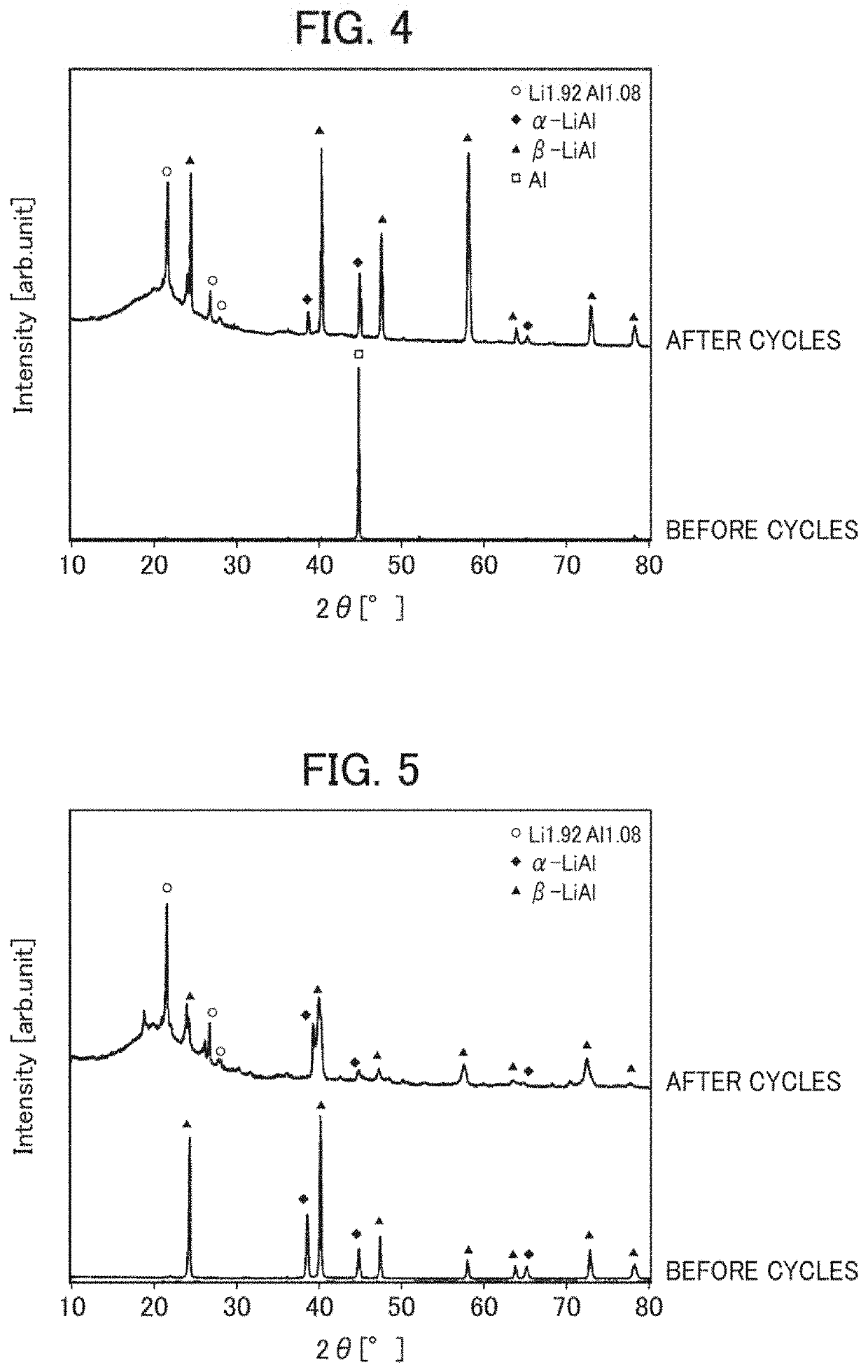Solid-state battery and method for producing solid-state battery
a solid-state battery and solid-state technology, applied in the field of solid-state batteries, can solve the problems of difficult to take advantage of the intrinsic characteristics of aluminum-lithium alloys, low durability of lithium-ion batteries, etc., and achieve the effect of suppressing the decrease in aluminum from the anode electrode layer, suppressing charge and discharge, and not easily reducing the discharging capacity
- Summary
- Abstract
- Description
- Claims
- Application Information
AI Technical Summary
Benefits of technology
Problems solved by technology
Method used
Image
Examples
example 1
[0146]An aluminum foil having a thickness of 100 μm and a lithium foil having a thickness of 100 μm were superposed to obtain an anode electrode layer of Example 1.
[0147]Aluminum-lithium alloy powder was press molded to obtain an anode electrode layer of Comparative Example 1.
[0148]Solid-state batteries each incorporating an anode of Example 1 or an anode of Comparative Example 1 were prepared and used as solid-state batteries for a cycle test.
[0149]These solid-state batteries were subjected to 20, 50 and 100 cycles of charge and discharge.
[0150]Also, before the charge and discharge and for each cycle, discharging capacity and DCR resistance were measured.
[0151]The results are shown in FIGS. 2 and 3.
[0152]Further, X-ray diffraction of the anode of Example 1 before the charge and discharge and the anode of Example 1 after 100 cycles of charge and discharge was performed from a cathode side (aluminum layer side).
[0153]The results are shown in FIG. 4.
[0154]Similarly, X-ray diffraction ...
example 2 to example 6
[0164]An aluminum plate and a lithium plate were superposed so that the content of lithium was:[0165]38 mol % (Example 2),[0166]44 mol % (Example 3),[0167]50 mol % (Example 4),[0168]60 mol % (Example 5) or,[0169]80 mol % (Example 6), respectively, provided that the total of lithium and aluminum was assumed to be 100 mol %, to obtain anode electrode layers of Example 2 to Example 6.
[0170]Solid-state batteries incorporating the anode electrode layers of Example 2 to Example 6 were prepared in the same manner as in Example 1 to obtain solid-state batteries for cycle tests.
[0171]With respect to these solid-state batteries, charge and discharge of 1 to 100 cycles (1 to 20 cycles for Example 5 and Example 6) was performed.
[0172]Also, discharging capacity was measured before charge and discharge as well as for each cycle.
[0173]The results are given in FIG. 6.
[0174]The results shown in FIG. 6 will be discussed with reference to FIG. 7.
[0175]Here, FIG. 7 is a phase diagram of a two-component...
example 7
[0181]On an electrode obtained by coating an aluminum plate with a solid electrolyte layer in advance, an electrode coated with a cathode layer was superposed and pressure molded at a pressure of 4.5 ton / cm2 in a uniaxial press.
[0182]Thereafter, a lithium plate was placed under an anode electrode layer and pressure molded at a pressure of 1 ton / cm2 to prepare a solid-state battery.
[0183]An aluminum plate having a thickness of 100 μm and a lithium plate having a thickness of 100 μm were used as the anode electrode layer.
PUM
| Property | Measurement | Unit |
|---|---|---|
| thickness | aaaaa | aaaaa |
| Li ion conductivity | aaaaa | aaaaa |
| Li ion conductivity | aaaaa | aaaaa |
Abstract
Description
Claims
Application Information
 Login to View More
Login to View More - R&D
- Intellectual Property
- Life Sciences
- Materials
- Tech Scout
- Unparalleled Data Quality
- Higher Quality Content
- 60% Fewer Hallucinations
Browse by: Latest US Patents, China's latest patents, Technical Efficacy Thesaurus, Application Domain, Technology Topic, Popular Technical Reports.
© 2025 PatSnap. All rights reserved.Legal|Privacy policy|Modern Slavery Act Transparency Statement|Sitemap|About US| Contact US: help@patsnap.com



